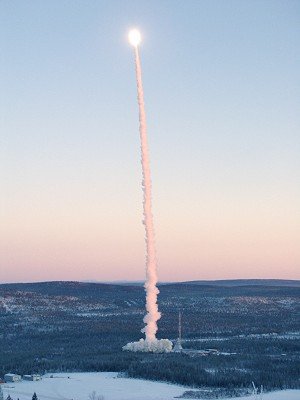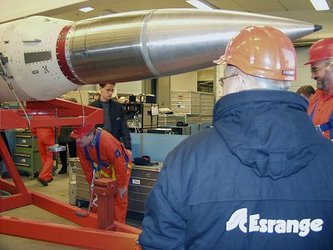Into space from the icy-cold Arctic
European launchers have come to be associated with French Guiana - powerful large rockets that lift-off from the steamy-hot equatorial base at Kourou. But ESA also uses much smaller launchers that rise into space from the snow-covered tundra of northern Sweden. EuroNews has covered the most recent launch of one of these Maxus sounding rockets.
"Esrange is today the operational base of the Swedish Space Corporation and it is here that we launch sounding rockets, large stratospheric balloons, that we test new aerospace vehicles and also control satellites in orbit," explained the base's spokeswoman Johanna Bergström-Roos.
The region north of the Arctic Circle is an immense snow-scape, where reindeer in the pine forests are practically the sole inhabitants. "The Kiruna site was chosen for several reasons, one of them being its isolated position. Our rockets can fall back to Earth without any safety problems, with nobody living in the impact areas."
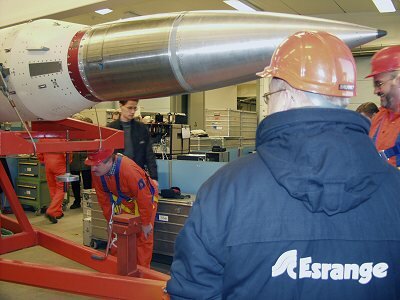
The Maxus rocket is a 12 tonne, slender 15 metre tall vehicle, with a single solid-propulsion stage and an upper section carrying the scientific payload. The rocket is the result of a joint venture between EADS-Space Transportation, Germany, and the Swedish Space Corporation.
With the mission sponsored by ESA, the eight experiments on the Maxus-6 launch relate to, for instance, silicon growth, solidification of aluminium alloys, plant growth, and the physical behaviour of foams – with potential applications in semiconductor production and new materials. "Gravity on Earth causes all the liquid in foams to flow out and the foam becomes dry very quickly," explained Dominique Langevin, one of the experimenters from the University of Paris-Sud. "In microgravity conditions, on the contrary, the liquid remains, so one can study what happens when foams contain more liquid. We cannot conduct such experiments in our laboratories on the ground."
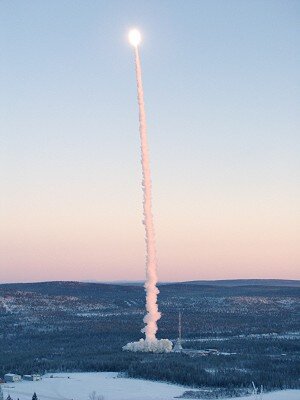
The campaign preparing the launch is nearing the final countdown, as ESA's sounding rocket project manager Wolfgang Herfs describes the objectives of the Maxus programme. "The sounding rockets offer periods of near-weightlessness that range from 3 minutes to 13 minutes. The Maxus-6 launch will provide a long 12.5 minutes of microgravity to a scientific payload of 477 kg."
Nights are long and bitterly cold in Lapland. Temperatures can drop to minus 30 C. In the night, the Aurora Borealis bathes the launch site in an eerie light for the spectacle that is about to take place.
As for every rocket launch, faces are tense as they monitor the consoles. The engineers are anxious to fulfil their contract for the scientists whose experiments are on board.
Launch day
The sun has just risen on 22 November. A large puff of smoke surrounds the Maxus as it lifts off, rising very quickly into the pale blue sky. Its engine propels it for just over a minute and then it is separated from the payload which continues on its ballistic trajectory reaching an apogee of 706 kilometres just 7.5 minutes after leaving the ground.
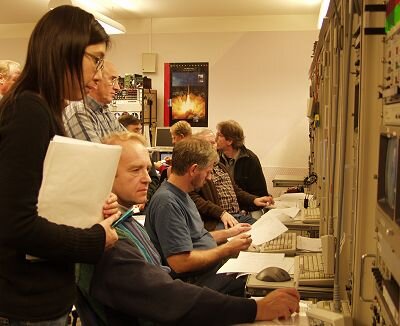
During the flight and particularly during the period of microgravity, science data from the experiments are relayed back to the ground. Helicopter crews prepare to quickly retrieve the science canister which floats back down under its parachute. No time is wasted as some experiments could suffer from the intense cold. The scientists are also impatient to see the results.
Back in the payload integration hall at Esrange, the science experiments are withdrawn. The Maxus-6 mission appears to be a great success. Three of the experiments will get a slightly reduced scientific return. But overall, the scientists are gleaming with satisfaction as they start analysing the results from the flight.
Contrary to the saying that "things go up in smoke" (implying that they are lost for ever), what goes up with the Maxus rockets must safely come down. Maxus-6, mission accomplished! At Esrange, thoughts turned already to the next flight, Maser 10 scheduled for spring 2006.
EuroNews
EuroNews is a key medium for delivering international information with a European point of view. Broadcast in 79 countries, EuroNews reaches 144 million households in Europe, the Middle East, Africa, Central Asia and North and Latin America via cable, digital satellite and through terrestrial channels. This Space Magazine is produced and broadcast every two weeks, with a new programme starting every second Friday. Each magazine is four minutes long and broadcast 21 times in one week, including evening prime time on Fridays and Saturdays, in order to reach a maximum audience.
Broadcast times
| Monday | 12:45 | 18:15 | 00:15 | |
|---|---|---|---|---|
| Tuesday | 12:45 | 18:15 | 00:15 | |
| Wednesday | 12:45 | 18:15 | 00:15 | |
| Thursday | 12:45 | 18:15 | 00:15 | |
| Friday | 17:45 | 20:45 | 00:15 | |
| Saturday | 12:45 | 21:15 | 00:15 | |
| Sunday | 12:45 | 18:15 | 00:15 |



